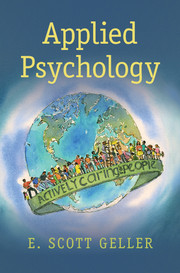Book contents
- Frontmatter
- Dedication
- Contents
- Foreword
- Preface: The Actively Caring for People (AC4P) Movement
- About the Authors
- Acknowledgments
- INTRODUCTION TO PART I EVIDENCE-BASED PRINCIPLES OF AC4P
- INTRODUCTION TO PART II APPLICATIONS OF AC4P PRINCIPLES
- Epilogue: Where Do We Go from Here?
- Subject and Name Index
- References
INTRODUCTION TO PART II - APPLICATIONS OF AC4P PRINCIPLES
Published online by Cambridge University Press: 05 March 2016
- Frontmatter
- Dedication
- Contents
- Foreword
- Preface: The Actively Caring for People (AC4P) Movement
- About the Authors
- Acknowledgments
- INTRODUCTION TO PART I EVIDENCE-BASED PRINCIPLES OF AC4P
- INTRODUCTION TO PART II APPLICATIONS OF AC4P PRINCIPLES
- Epilogue: Where Do We Go from Here?
- Subject and Name Index
- References
Summary
I started my professional career in 1969 as assistant professor of psychology at Virginia Polytechnic Institute and State University (Virginia Tech). Assisted by undergraduate and graduate students, I developed a productive laboratory and research program in cognitive psychology. My tenure and promotion to associate professor were based entirely upon my professional scholarship in this domain. However, in the mid-1970s I became concerned the laboratory work had limited potential for helping people. This conflicted with my personal mission to make beneficial large-scale differences in people's quality of life. Consequently, I turned to another line of research.
I was convinced behavior-based psychology or applied behavioral science (ABS) had the greatest potential for solving organizational and community problems. Accordingly, I focused my research on finding ways to make this happen. Inspired by the first Earth Day in April 1970, my students and I developed, evaluated, and refined a number of community-based techniques to increase the frequency of environmentally responsible behavior (ERB) and decrease the occurrence of environmentally harmful behavior (EHB). This prolific research program culminated with the 1982 book, Preserving the Environment: New Strategies for Behavior Change, which I coauthored with Dr. Richard A. Winett and Dr. Peter B. Everett.
My students and I applied behavioral science to a number of issues beyond environmental protection. These included prison administration, school discipline, community theft, transportation management, and alcohol-impaired driving. In the mid-1970s we began researching strategies for increasing the use of vehicle safety belts. This led to a focus on the application of behavioral science to the prevention of unintentional injuries in organizational and community settings.
FROM BASIC TO APPLIED RESEARCH
My early scholarship was divided between basic (i.e., reaction time) and applied (i.e., behavioral science) research. Once awarded tenure in 1976, I started giving more attention to behavioral community psychology, which was clearly not mainstream in those days. My students and I continued to demonstrate the efficacy of applying behavior-focused psychology in community and organizational settings to benefit the environment and people's health, safety, and well-being. By 1979, the year I was promoted to the rank of professor, my research and scholarship had transitioned completely from basic to applied psychology, particularly the practice of ABS to improve people's quality of life on a macro scale.
- Type
- Chapter
- Information
- Applied PsychologyActively Caring for People, pp. 295 - 300Publisher: Cambridge University PressPrint publication year: 2016



